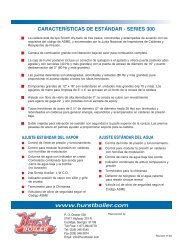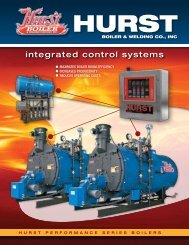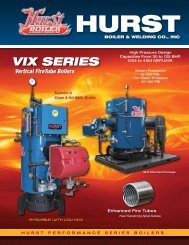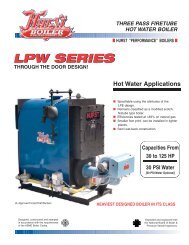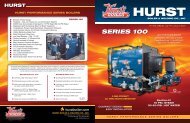Component & System Guide - Hurst Boiler
Component & System Guide - Hurst Boiler
Component & System Guide - Hurst Boiler
You also want an ePaper? Increase the reach of your titles
YUMPU automatically turns print PDFs into web optimized ePapers that Google loves.
H U R S T B O I L E R S E R I E S “ M H ”<br />
from the hopper by a venturi, powered by a high-pressure blower, into a rejection line<br />
which reintroduces the “char” into the upper section of the furnace to complete<br />
combustion. The gases exit the boiler at approximately 400°F to 500°F, they then pass<br />
through an air preheater --- preheaters are installed on units anticipated to be operating<br />
with moist fuel. It has been found that 1% of boiler efficiency can be realized for every<br />
50°F increase of the combustion air above ambient. The temperature drop of the flue<br />
gases across the preheater is approximately 120°F with a similar combustion air<br />
temperature increase. The flue gases are then directed through a multi-cyclone to<br />
remove up to 90% of the particulate matter being carried along with the gases. The<br />
ash falls as it’s collected in the lower cyclone bin through a rotary or flapper-type air<br />
lock from which it is removed via re-injection to assure complete combustion of all<br />
fuels, subject to state regulations, or deposited in a container. HBC also supplies feed<br />
water economizers, steam super heaters, steam combustion air heaters and HBC’s<br />
FGR (flue gas recirculation) system. The flue gases exit the multi-cyclone, pass<br />
through the Induced Draft fan and ultimately out thru secondary emission controls<br />
and/or the exhaust stack.<br />
Secondary pollution controls may be required depending on the types of fuels utilized,<br />
BTU input of the system and state or federal regulation. <strong>Hurst</strong> is prepared to<br />
accommodate and integrate all types of secondary controls into our systems. Typically,<br />
there a three types of secondary particulate control systems available. The first is the<br />
wet scrubber.<br />
13



